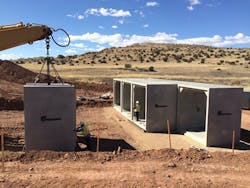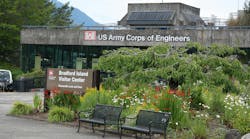Changing With the Times
Dry-cast box sections for a precast concrete box culvert, specified for a new road to connect the Navajo town of Alamo with Interstate 40 in New Mexico, represent a milestone. In a state where wet-cast box sections and cast-in-place construction have been a preferred product and construction method, the use of dry-cast concrete boxes on a federally funded highway project is attracting attention. Alamo is home to approximately 2,000 Navajo tribal members. The new road will improve access to Alamo and bring greater prosperity to the town and other nearby communities.
Because of the culvert hydraulics required to carry flow under the road during periods of heavy rainfall, a four-barrel (10-ft-by-10-ft) box system was specified by the Bureau of Indian Affairs (BIA) on the alignment of an arroyo. An arroyo is a dry creek, streambed or gulch that temporarily or seasonally fills and flows after sufficient rain. The culvert has a dual purpose making it unique in the area: Not only does it manage large volumes of storm water, but it also serves as a passageway for ranchers and their cattle.
Specifications of the BIA call for concrete mixes with 4% entrained air to protect the concrete from freeze/thaw damage. Entrained air creates a large number of closely spaced, small air bubbles in the hardened concrete that relieve ice pressure buildup by acting as expansion chambers. Forterra tested every section of precast box for entrained air content before delivery to the job. It proved without a doubt that dry-cast concrete boxes could meet the stringent specification of the BIA.
Meridian Contracting constructed the culvert on a site of variable soil conditions by first creating a bed for the boxes that could be best described as a concrete floor. Forterra provided the contractor with a jointing procedure that would meet the watertight requirement of the specification. The procedure was enhanced using preformed flexible plastic coils used for sealing box culverts and other precast products and systems. A field representative from Forterra was on site each day of the installation to oversee placement of the box sections and advise the contractor on technical matters. The contractor found that the precast method for constructing the culvert ensured greater control over the quality than a cast-in-place system, control over the finish of the product and faster installation.
Forterra began shipping 44 sections of dry-cast box to the site in January 2016, and by March 28 the culvert was in place on the new road alignment. Site conditions limited installation of the system to two boxes per day. The project has set a precedent for supplying dry-cast boxes in specifications calling for box culverts on New Mexico’s critical infrastructure.
Arturo Chavarria, P.E., is technical resource engineer for Forterra Pipe & Precast. Chavarria can be reached at [email protected].


